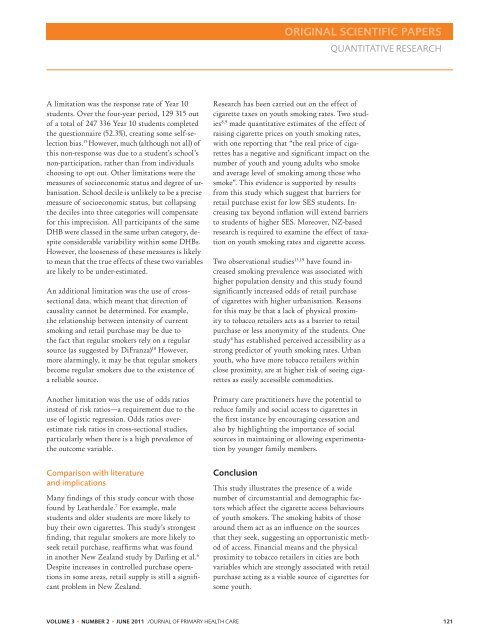single PDF of the entire issue - The Royal New Zealand College of ...
single PDF of the entire issue - The Royal New Zealand College of ...
single PDF of the entire issue - The Royal New Zealand College of ...
You also want an ePaper? Increase the reach of your titles
YUMPU automatically turns print PDFs into web optimized ePapers that Google loves.
ORIGINAL SCIENTIFIC PAPERS<br />
quantitative research<br />
A limitation was <strong>the</strong> response rate <strong>of</strong> Year 10<br />
students. Over <strong>the</strong> four-year period, 129 315 out<br />
<strong>of</strong> a total <strong>of</strong> 247 336 Year 10 students completed<br />
<strong>the</strong> questionnaire (52.3%), creating some self-selection<br />
bias. 15 However, much (although not all) <strong>of</strong><br />
this non-response was due to a student’s school’s<br />
non-participation, ra<strong>the</strong>r than from individuals<br />
choosing to opt out. O<strong>the</strong>r limitations were <strong>the</strong><br />
measures <strong>of</strong> socioeconomic status and degree <strong>of</strong> urbanisation.<br />
School decile is unlikely to be a precise<br />
measure <strong>of</strong> socioeconomic status, but collapsing<br />
<strong>the</strong> deciles into three categories will compensate<br />
for this imprecision. All participants <strong>of</strong> <strong>the</strong> same<br />
DHB were classed in <strong>the</strong> same urban category, despite<br />
considerable variability within some DHBs.<br />
However, <strong>the</strong> looseness <strong>of</strong> <strong>the</strong>se measures is likely<br />
to mean that <strong>the</strong> true effects <strong>of</strong> <strong>the</strong>se two variables<br />
are likely to be under-estimated.<br />
An additional limitation was <strong>the</strong> use <strong>of</strong> crosssectional<br />
data, which meant that direction <strong>of</strong><br />
causality cannot be determined. For example,<br />
<strong>the</strong> relationship between intensity <strong>of</strong> current<br />
smoking and retail purchase may be due to<br />
<strong>the</strong> fact that regular smokers rely on a regular<br />
source (as suggested by DiFranza) 18 However,<br />
more alarmingly, it may be that regular smokers<br />
become regular smokers due to <strong>the</strong> existence <strong>of</strong><br />
a reliable source.<br />
Ano<strong>the</strong>r limitation was <strong>the</strong> use <strong>of</strong> odds ratios<br />
instead <strong>of</strong> risk ratios—a requirement due to <strong>the</strong><br />
use <strong>of</strong> logistic regression. Odds ratios overestimate<br />
risk ratios in cross-sectional studies,<br />
particularly when <strong>the</strong>re is a high prevalence <strong>of</strong><br />
<strong>the</strong> outcome variable.<br />
Comparison with literature<br />
and implications<br />
Many findings <strong>of</strong> this study concur with those<br />
found by Lea<strong>the</strong>rdale. 7 For example, male<br />
students and older students are more likely to<br />
buy <strong>the</strong>ir own cigarettes. This study’s strongest<br />
finding, that regular smokers are more likely to<br />
seek retail purchase, reaffirms what was found<br />
in ano<strong>the</strong>r <strong>New</strong> <strong>Zealand</strong> study by Darling et al. 6<br />
Despite increases in controlled purchase operations<br />
in some areas, retail supply is still a significant<br />
problem in <strong>New</strong> <strong>Zealand</strong>.<br />
Research has been carried out on <strong>the</strong> effect <strong>of</strong><br />
cigarette taxes on youth smoking rates. Two studies<br />
8,9 made quantitative estimates <strong>of</strong> <strong>the</strong> effect <strong>of</strong><br />
raising cigarette prices on youth smoking rates,<br />
with one reporting that “<strong>the</strong> real price <strong>of</strong> cigarettes<br />
has a negative and significant impact on <strong>the</strong><br />
number <strong>of</strong> youth and young adults who smoke<br />
and average level <strong>of</strong> smoking among those who<br />
smoke”. This evidence is supported by results<br />
from this study which suggest that barriers for<br />
retail purchase exist for low SES students. Increasing<br />
tax beyond inflation will extend barriers<br />
to students <strong>of</strong> higher SES. Moreover, NZ-based<br />
research is required to examine <strong>the</strong> effect <strong>of</strong> taxation<br />
on youth smoking rates and cigarette access.<br />
Two observational studies 13,19 have found increased<br />
smoking prevalence was associated with<br />
higher population density and this study found<br />
significantly increased odds <strong>of</strong> retail purchase<br />
<strong>of</strong> cigarettes with higher urbanisation. Reasons<br />
for this may be that a lack <strong>of</strong> physical proximity<br />
to tobacco retailers acts as a barrier to retail<br />
purchase or less anonymity <strong>of</strong> <strong>the</strong> students. One<br />
study 4 has established perceived accessibility as a<br />
strong predictor <strong>of</strong> youth smoking rates. Urban<br />
youth, who have more tobacco retailers within<br />
close proximity, are at higher risk <strong>of</strong> seeing cigarettes<br />
as easily accessible commodities.<br />
Primary care practitioners have <strong>the</strong> potential to<br />
reduce family and social access to cigarettes in<br />
<strong>the</strong> first instance by encouraging cessation and<br />
also by highlighting <strong>the</strong> importance <strong>of</strong> social<br />
sources in maintaining or allowing experimentation<br />
by younger family members.<br />
Conclusion<br />
This study illustrates <strong>the</strong> presence <strong>of</strong> a wide<br />
number <strong>of</strong> circumstantial and demographic factors<br />
which affect <strong>the</strong> cigarette access behaviours<br />
<strong>of</strong> youth smokers. <strong>The</strong> smoking habits <strong>of</strong> those<br />
around <strong>the</strong>m act as an influence on <strong>the</strong> sources<br />
that <strong>the</strong>y seek, suggesting an opportunistic method<br />
<strong>of</strong> access. Financial means and <strong>the</strong> physical<br />
proximity to tobacco retailers in cities are both<br />
variables which are strongly associated with retail<br />
purchase acting as a viable source <strong>of</strong> cigarettes for<br />
some youth.<br />
VOLUME 3 • NUMBER 2 • JUNE 2011 J OURNAL OF PRIMARY HEALTH CARE 121

















